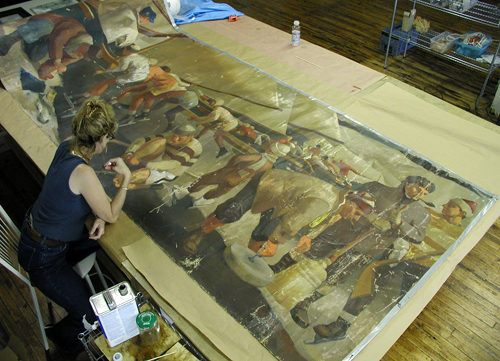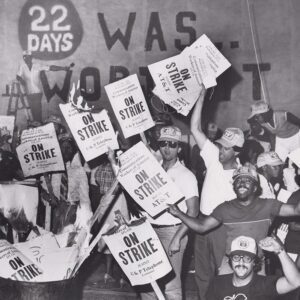October 31, 2005
Postal Landscape Includes Art of the New Deal
(This article was first published in the November/December 2005 issue of The American Postal Worker magazine.)
If the facility you work in was built during the Great Depression, chances are that its public lobby features a unique work of art.
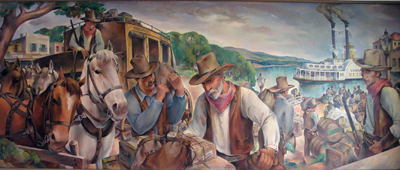
Though many post offices have undergone repeated renovations, most of the art has been preserved. Today, about 1,000 of the 1,200 murals of that era are still on display.
The murals have drawn renewed attention for both their artistic and historical value. Many postal workers and postal customers, however, are unaware of how the murals came to serve as a testament to the American spirit and the country’s efforts — amid more than a decade of economic misery — to connect a treasured past with a promising future.
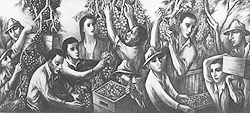


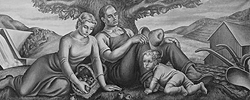
Following the stock market crash of October 1929, banks failed, businesses and factories closed, farm income fell by 50 percent. President Herbert Hoover believed our economy was fundamentally sound but had been shaken by international events. He told Americans that recovery would come on its own, that bold action by the federal government was not needed. But by 1932,with one in four Americans unemployed, Hoover was overwhelmingly defeated for reelection by Franklin D. Roosevelt, and the “New Deal” was born.
FDR’s administration instituted many wide-ranging programs to revive the nation’s economy. Important New Deal innovations included rural electrification projects, the establishment of Social Security, an expansion of workers’ rights to organize, and the creation of numerous public works projects to employ the jobless. Along with parks and dams, construction work in federal relief projects included post offices and other public buildings.
These projects provided income to millions of households, including those of the nation’s artists, writers, and photographers. As one of FDR’s top administrators explained to critics of relief programs for artists, “they have got to eat just like other people.”
Although a variety of New Deal programs — such as the Works Progress Administration’s Federal Art Project — employed artists to produce works for public buildings, most of the postal murals were completed by artists who won their commissions under a competitive program established by the Treasury Department’s Section on Fine Arts. FDR himself wanted the arts programs to convey a positive message to remind Americans to “remember their roots” and inspire them to look ahead to better times.
He directed that the murals should be “native, human, eager and alive,” art that “was painted for the people of this country by their own kind … about the things they know and have looked at often.”
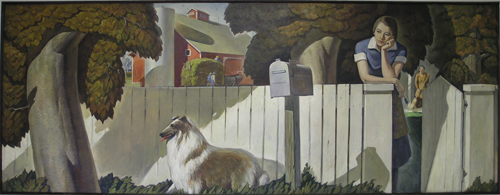
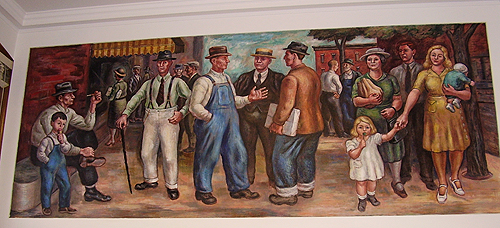
The murals were intended to be uplifting and non-controversial; however, art being in the eye of the beholder, many communities rejected the designs initially submitted.Artists seeking commissions were given guidelines that called for the murals to depict local events or people at work in an occupation common to the community and that reflected the heritage of the towns in which they were to appear. As such, most of the murals pay homage to local history, labor, and everyday life. Some depict an idyllic agrarian past leading to a promising industrial future. (None of the commissioned works show the homeless or people waiting in breadlines.)
Some of the murals that went on display later met with opposition that continues to this day: a mural in Washington, D.C.’s landmark Old Post Office building that offers an image of an Indian attack has drawn criticism for many years, and the citizens of Linden, TX, are debating whether to remove a mural portraying a cotton-picking scene that has offended civil rights advocates.
Some of the murals disappeared over the years, and many others need restoration. The USPS officer for Federal Preservation in Arlington, VA is currently working with arts groups and communities to catalogue and preserve the New Deal-era murals and sculpture that remain. (If you know of one that is “lost” or needs restoration, please send an e-mail to dallan.c.wordekemper@usps.gov.)
Many art critics and historians consider the New Deal art that is preserved in postal facilities today to be a vital part of our nation’s cultural heritage. Take a closer look next time and see if you see more.
